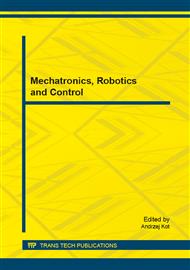[1]
M. Yamakado, J. Takahashi, S. Saito, A. Yokoyama, M Abe: Improvement in vehicle agility and stability by G-Vectoring control, (Vehicle System Dynamics, Vol. 48, Supplement, 2010, 231–254).
DOI: 10.1080/00423111003706748
Google Scholar
[2]
M. Sibielak, J. Konieczny, J. Kowal, W. Rączka, D. Marszalik: Optimal Control of Slow-Active Vehicle Suspension – Results of Experimental Data, (Journal of Low Frequency Noise Vibration and Active Control, ISSN 1461-3484, Vol. 32, No. 1&2, (2013).
DOI: 10.1260/0263-0923.32.1-2.99
Google Scholar
[3]
M. Ahmadian, C.A. Pare: A Quarter-Car Experimental Analysis of Alternative Semiactive Control Methods, (Journal of Intelligent Material Systems and Structures, Vol. 11, August 2000).
DOI: 10.1106/mr3w-5d8w-0lpl-wguq
Google Scholar
[4]
A. Wray, A. Jimenez, E. Anderfaas, B. Hopkins, P. Lenoach: Magneto-Rheological Fluid Semiactive Suspension System Performance Testing on a Stryker Vehicle, (SAE Technical Paper 2006-01-1379, 2006).
DOI: 10.4271/2006-01-1379
Google Scholar
[5]
A.A. Alexandridis, J.P. Goldasz: Simplified Model of the Dynamics of Magneto-Rheological Dampers, (Mechanics, Vol. 24 , No. 2, 2005).
Google Scholar
[6]
W. Rączka, M. Sibielak, J. Kowal, J. Konieczny: Application of an SMA Spring for Vibration Screen Control, (Journal of Low Frequency Noise Vibration and Active Control, ISSN 1461-3484, Vol. 32, No. 1&2 (2013) 117–132).
DOI: 10.1260/0263-0923.32.1-2.117
Google Scholar
[7]
T. Nabagło, A. Jurkiewicz, M. Apostoł, P. Micek: Construction and simulation of a 2S1 tracked vehicle mod-el and its verification using vertical forces on the road wheels while over-coming a single obstacle, (Solid State Phenomena 2011, Vol. 177, pp.168-176.
DOI: 10.4028/www.scientific.net/ssp.177.168
Google Scholar
[8]
H.S. Ryu, D.S. Bae, J.H. Choi; A.A. Shabana: A compliant track link model for high-speed, high-mobility tracked vehicles, (Int. J. Numer. Meth. Engng 2000, 48, 1481-1502).
DOI: 10.1002/1097-0207(20000810)48:10<1481::aid-nme959>3.0.co;2-p
Google Scholar
[9]
J.Y. WONG: Dynamics of Tracked Vehicles, (Vehicle System Dynamics, 28 (1997). pp.197-219).
DOI: 10.1080/00423119708969354
Google Scholar
[10]
K. Lee: A Numerical Method for Dynamic Analysis of Tracked Vehicles of High Mobility, (KSME international Journal 2000, Vol. 14, No. 10, pp.1028-1040).
DOI: 10.1007/bf03185057
Google Scholar
[11]
ADAMS ver. 2010, Help Documentation (ADAMS/View, Solver). MSC. Software (2010).
Google Scholar
[12]
T. Kubela, A. Pochyly, V. Singule: Advanced Tools for Multi-Body Simulation and Design of Control Structures Applied in Robotic System Development, (Solid State Phenomena 2010, Vol. 164, pp.387-391).
DOI: 10.4028/www.scientific.net/ssp.164.387
Google Scholar
[13]
K. Huh; B.H. Cho, J.H. Choi: Development of a track tension monitoring system in tracked vehicles on flat ground, (Proc Instn Mech Engrs, Part D: Journal of Automobile Engineering 2011, Vol. 215, 567-578).
DOI: 10.1243/0954407011528158
Google Scholar
[14]
Final Report for U.S. Army Tank-Automotive Command, Terrain severity data generation at Yuma Proving Ground, TACOM Report No. 13491, Contract No. DAAE07-89-C-R106, NATC Project No. 20-17-399, Octo-ber 1989 - November (1990).
Google Scholar
[15]
R.A. Lee, W.F. Lins: Human Vibration Measuring Instrument, Tech-nical Report No. AD785648 (U.S. Army Tank-Automotive Command, Warren, Michigan, 1973).
Google Scholar
[16]
J. Kowal, J. Pluta, J. Konieczny, A. Kot: Energy Recovering in Active Vibration Isolation System – Results of Ex-perimental Research, (Journal of Vibration and Control, ISSN 1077-5463, Vol. 14, No. 7 (2008) 1075–1088).
DOI: 10.1177/1077546308088980
Google Scholar
[17]
A. Mężyk, E. Świtoński, S. Kciuk, W. Klein: Modelling and Investigation of Dynamic Parameters of Tracked Vehicles, (Mechanics and Mechanical Engineering, Vol. 15, No. 4 (2011) 115-130, Technical University of Lodz).
Google Scholar
[18]
D.N. Assanis, W. Bryzik, M.P. Castanier, I.M. Darnell, Z.S. Filipi, G.M. Hulbert, D. Jung, Z.D. Ma, N.C. Perkins, C. Pierre, C.M. Scholar, Y. Wang, G. Zhang: Modeling and Simulation of an M1 Abrams Tank with Advanced Track Dynamics and Integrated Virtual Diesel Engine, (Mechanics of Structures and Machines, 27(4), 453-505 (1999).
DOI: 10.1080/08905459908915707
Google Scholar


